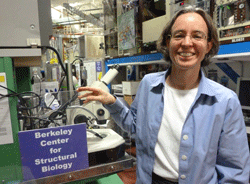Corie Ralston’s appointment as Head of the Berkeley Center for Structural Biology (BCSB) has her busy looking at budgets, funding, and big-picture goals. The biophysicist staff scientist has been with BCSB for more than 10 years, so much of what she’s considering comes from an intimate familiarity with the day-to-day operations and challenges of the facility.
 Ralston joined BCSB, which runs five of the crystallography beamlines at the ALS, as a staff scientist in 2002 and took on the larger role of operations manager about five years ago. While Ralston will definitely keep a hand in the crystallography research she’s been doing, her work balance will shift more toward user relations and funding development. Her new position entails managing a group of 12 employees and a budget of $3 million.
Ralston joined BCSB, which runs five of the crystallography beamlines at the ALS, as a staff scientist in 2002 and took on the larger role of operations manager about five years ago. While Ralston will definitely keep a hand in the crystallography research she’s been doing, her work balance will shift more toward user relations and funding development. Her new position entails managing a group of 12 employees and a budget of $3 million.
In her beamline research, Ralston studies chaperonin protein structures, which she describes as “the really important medics in our cells” that can fix mis-folded proteins. Since mis-folded proteins may cause many diseases, such as Alzheimer’s and Parkinson’s, a better understanding of chaperonins could lead to breakthrough drug developments. Ralston’s research is part of a collaboration with Stanford that was organized by former BCSB Head Paul Adams.
“The thing about keeping my hand in crystallography is that it gives me a sense of what’s needed at the beamlines,” says Ralston. “Especially because I work on a hard project – it’s not easy to crystallize; it’s not easy to solve; the data is always sub-optimal, so I have to have the best tools at the beamline.”
Beamline engineering developments are what keep Ralston’s crystallography work moving forward, and managing this process will be key to her new position as Head of BCSB. From software tools that advance data processing and collection to hardware tools like beamline optics and robotic controls, engineering development is what keeps the ALS crystallography beamlines at the forefront.
“It’s a challenge because whenever you’re doing something new that increases the flux of the beamline, you’re in danger of making it less stable,” says Ralston. “Maintaining this balance between stability and technological advancement is one of our biggest challenges.”
Besides maintaining existing BCSB funding – the majority of which comes from contracts with participating research teams (PRT), Howard Hughes Medical Institute, and an NIH grant – Ralston hopes to develop new funding sources by restructuring beamline contracts. She’d like to be able to offer smaller amounts of guaranteed beamtime to PRT users with smaller budgets, which is a more common situation in today’s economy. Ralston would then launch an aggressive PR campaign, travelling to present the new option to companies and academic institutions nationwide.
“I would really love BCSB to be the first thing someone thinks of when they need to solve a structure in order to move forward with their research,” says Ralston.
In Her Spare Time: Award-Winning Science Fiction Writer
In addition to her new appointment at BCSB, Ralston has recently been recognized for her science fiction writing achievements, winning first prize in an international competition organized by the UK’s national synchrotron facility, Diamond Light Source. Her short story “The Sound of Science” follows a series of interactions between a beamline scientist and an alien as the scientist leads a group tour of a synchrotron. While the scientist begins the tour feeling frustrated with the inconvenience of taking time away from her work, her interactions with the curious alien lead her to some new realizations about science and our species’ interconnectedness.
“We all depend on each other for various areas of expertise,” Ralston muses. “I don’t really know how my car works and I can’t build a coffeemaker, but I can fix the beamline.”
The inspiration for her story came partly from Ralston’s personal experience at the ALS. “I do give a lot of tours and often I’m not initially enthusiastic about doing it, but then the people on my tours are so amazed by everything that it serves as a nice reminder of why I like this place so much,” says Ralston. “I thought to include an alien maybe because some of the people on my tour seem alien to me.”
Ralston has been writing science fiction since she was a teenager, becoming serious about her pursuit about 10 years ago. She now has more than a dozen published stories at the professional level. She recently finished a draft of her first novel, which is set in post-apocalyptic Bay Area.
Read Corie’s winning entry “The Sound of Silence” and see her describing her work on Beamline Highlight 8.2: Structural Biology.